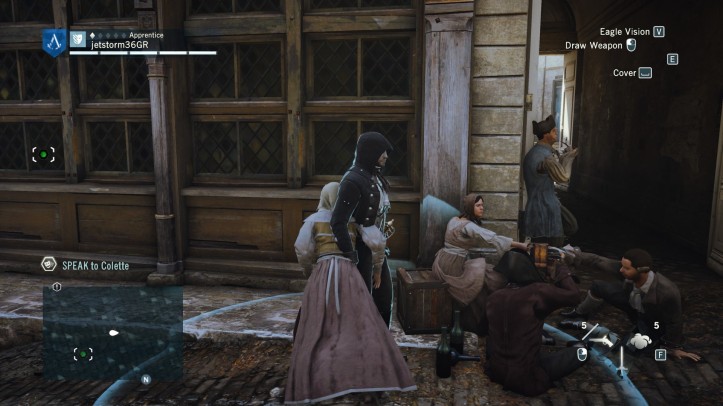As I mentioned last week, I’ve started playing Assassin’s Creed: Unity, and I’m really enjoying it. Today I wanted to chat about the way that movement works – that is, how the player moves through the environment, and how NPC behaviour is built around that style of movement.
I’ve talked a lot lately about how the Arkham games divide space vertically into three lanes. There’s the ground lane, where Batman is running along the footpath, the rooftop lane, where he’s hopping at, uh, roof level, and the high lane, where he’s mostly moving through open air, gliding from tall tower to tall tower. The Assassin’s Creed games have a similar sort of thing, but in their case it’s typically 1) ground lane, 2) awning lane (the covering above the street), and 3) rooftop lane. The emphasis is brought lower, in that sense. The awning lane is still right above the ground – it’s basically at head height for people on the street.
All of this is just to note that you as player probably see a lot more of the ground-level population than in a game like Arkham City. There’s also a more diverse population – it’s not just varying types of thug, there’s also civilians everywhere too. That means they’re more diverse in the sense that they’re doing a wider variety of things. It’s all different people going around their day, doing all the normal things that happen over the course of a day – not just thugs doing push-ups and loitering.

But really how much effort is put into each individual NPC? I stood by this trio on the right and waited to see how long it would take their actions to loop. They clinked mugs, had a couple lines of dialogue, the man in the middle pointed at the girl and put his hand on her knee, and then they laughed and clinked glasses again. And that was the loop. Now, we might decide that it’s quite a short loop – it’s probably, mm, between 15 and 30 seconds. So it’s not super long – which means if you’re just standing around, it becomes pretty easy to see the limitations of what’s happening. Does that mean the game’s bad? Not really. What’s interesting about it, to me, is how the length of these action loop ties into the style of movement that the game encourages.
If you think about movies and so on, there’s often lots of background actors – just kinda random nobodies who’re there to fill the space. Because the director can control the cuts and edits and framing of each shot, you don’t necessarily always notice that those background figures are just kinda doing nothing. There are, of course, times where it shows through more than usual.
When Bond is talking to Plenty O’Toole (fuck’s sake), watch the guy in the left of the shot, in the weird striped, uh, shirts. He’s just staring at the two main characters. You can also see him in the very first shot, standing right behind Bond and just staaaaaaaring at him. So there are gaps here and there, even in film. We don’t really notice necessarily, and even when we do it doesn’t always matter. In video games it’s obviously harder, because it all has to be programmed into the NPCs beforehand and because the player can just stand around and really quickly break the illusion. That’s where movement enters the picture.
In Assassin’s Creed, you’re never just standing around. You’re always on the move – running or climbing or whatever. I’ve said that if you stand and watch an NPC, they’ve got a loop that only lasts about 30 seconds. But if you’re on the move, which you almost always are, that’s a great length. There’s enough different types of characters doing enough different things that when you’re sprinting along, it looks like you’re in the middle of a realistic busy city street. You’re only really seeing each NPC for a couple of seconds at a time, so the loop length isn’t an issue. It’s tailored to the way that you’re moving around the environment. The broad pool of NPC action is emphasised over the long-term illusionistic behaviour of any individual NPC.
If you were playing something like Hitman, of course, the pacing would have to be much different. There’s more of an emphasis on stealth, on waiting for the gap in the guard patrol or whatever other perfect moment. You’re likely to spend a lot more time in the one place, which means the loops have to work differently. And arguably Assassin’s Creed has moments of this – the little stealth missions, the sneaky assassinations or whatever – and in those moments the illusion of NPC behaviour tends to be more fragile. The limits become more obvious. The speed with which Assassin’s Creed pushes you through the world, then, turns out to be the most stable way to represent a mass of NPCs with a limited behavioural loop.


[…] so I know I said I loved AC: Unity but I played it again and I hate it. I had like a whole bunch of thoughts about […]
LikeLike
[…] broom sweeping interior locations. Even in games with more sophisticated NPC loops – such as Assassins Creed Unity, which we talked about a few years back – the actual behaviours aren’t meant to connote […]
LikeLike